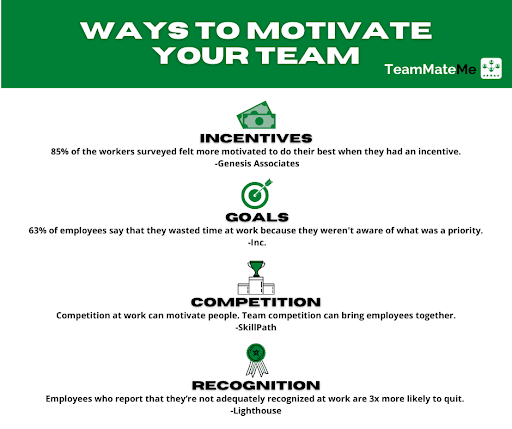In today's workplace, employee motivation is critical for success. Not only is a motivated organization less likely to experience turnover and conflict, but it's more likely to perform at a higher level and achieve goals.
The reason is simple. When people are motivated, they're engaged. And when they're engaged, they're likely to approach their work with greater intensity.(Pinder) They take a genuine, passionate interest and put forth a strong effort that not only accomplishes the task but makes way for innovation and improvement.(Rubin)
But, beware. Last year, Gallup reported a historically massive drop in employee engagement. (Gallup) So you can’t simply assume everyone is engaged and motivated by default. Smart leaders must be proactive and do the things that stir up fire within their team’s spirits.
What does motivate people?
So exactly what are those things that create an organic, burning desire from within? What is it that creates lasting motivation that doesn’t fizzle out? Well, let’s get this one out of the way — it’s not external incentives like money and financial compensation. The key to high performance is to create a workplace where people’s internal needs are met.
These internal needs include the desire to connect with others, be self-directed, and work on something meaningful. And an organizational structure that prioritizes these intrinsic motivators as essential elements of their workplace culture is more likely to have a workforce that’s fulfilled, motivated, and engaged.
In 2018, the Office of Financial Management, State Human Resources, developed the RAMP model, a human-centered framework inspired by scientific studies like Self-Determination Theory and Maslow's Hierarchy of Needs, to identify the true drivers of motivation. The RAMP model has four components — relationships, autonomy, mastery, and purpose — that organizations can use to create policies that motivate. (Washington State Office of Financial Management)
1. Relationships: Create Inclusive and Respectful Environments
Humans have a natural desire to feel connected and respected. Healthy social connections not only help us survive but thrive. These positive connections, which include the ones we have in the workplace, increase our physical and emotional well-being. Having meaningful relationships with others gives us a sense of value, as well as support and encouragement. s School Strategy
Promoting relationships in the workplace requires a high level of trust and communication. Acknowledgment and recognition must be built into communication standards. People must know their efforts are valued. Even a simple "thank you" goes a long way. Surveys show that people often disengage when they don't feel respected or treated fairly. So, acknowledge often and create opportunities to build social bonds.
2. Autonomy: Enable and Empower People to Do Their Best Work
Nobody likes to be micromanaged. And people with the potential to operate at a high level can only do so when given space and autonomy. Autonomy allows people to feel a sense of responsibility. And when it's combined with feedback and recognition, it makes incredible use of people's strengths.
You have to start by assuming that your team will use their time wisely and efficiently to complete their tasks. If they don't, that's a separate conversation. Build a framework where expectations are clearly defined and get out of the way so people can do their thing. If you focus on empowering and encouraging, your team will discover creative solutions to achieve goals.
3. Mastery: Facilitate Career and Personal Growth
The world is changing at a rapid pace, and the only way for organizations and individuals to achieve and maintain a competitive advantage is to never stop learning.(Singh) Our workplace must encourage continuous skill development. The quest for knowledge and mastery of a field or subject is fueled by curiosity, the desire for challenge, and the pursuit of recognition.
Create a culture of learning within your organization. Continuing education, workshops, lunch-and-learns, and attending industry conferences are just a few ways to stay at the forefront of the changes and developments within your industry while tapping into people's internal desire to grow and evolve.
4. Purpose: Define and Live By the "Why"
We're humans, not machines. And for our passions to be sparked and our performance to be stellar, we must operate with meaning. If the "why" isn't understood and in tune with our internal values, we won’t feel motivated to reach new heights. Not only that, but purpose is the touchstone that helps us regain clarity and focus when disruptions occur.
Purpose is a lot more than a mission statement (although they're a good start). You have to clearly identify what you’re working to achieve and show your team how, where, and why their work matters with quantifiable success metrics. When you stimulate the innate drive for purpose, it can produce the highest levels of motivation.
Wait! What About Money?
It's more effective for managers to look toward the RAMP model to build motivation rather than assuming financial incentives will do it. Research shows that monetary rewards, performance bonuses, promotions, and other external motivators can be counterproductive when the work involves creativity and cognitive abilities.(Shkoler & Kimura)
With that said, organizations need to establish the foundation of employee-employer relationships with competitive compensation packages. If basic life needs aren’t met, we can’t approach work with an enthusiastic frame of mind. And, in fact, if compensation and working conditions aren't acceptable, they become significant demotivating factors.
RAMP Up Your Team's Motivation
Creating a motivated workforce doesn't have to involve hanging posters with hokey inspirational phrases or listening to self-help coaches who yell too much. Developing a culture that promotes RAMP — relationships, autonomy, mastery, and purpose — will inspire high-performance organically.
Make people feel valued, respected, and heard, regardless of their position. Provide ongoing opportunities for learning and growth. And take time to regularly acknowledge how everyone's contributions are vital to the organization's success. When you lead this way, your team will be motivated and on track for greatness.


